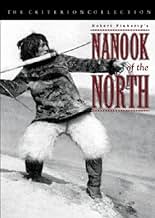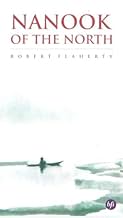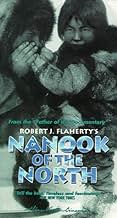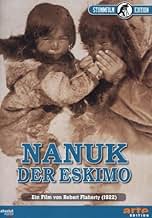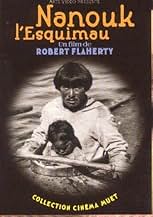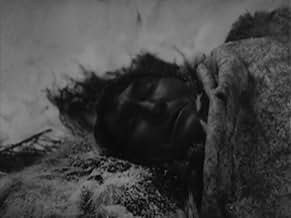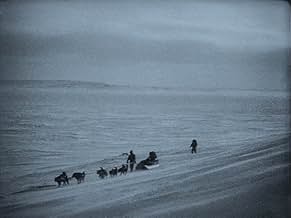IMDb RATING
7.6/10
14K
YOUR RATING
In this silent predecessor to the modern documentary, film-maker Robert J. Flaherty spends one year following the lives of Nanook and his family, Inuits living in the Arctic Circle.In this silent predecessor to the modern documentary, film-maker Robert J. Flaherty spends one year following the lives of Nanook and his family, Inuits living in the Arctic Circle.In this silent predecessor to the modern documentary, film-maker Robert J. Flaherty spends one year following the lives of Nanook and his family, Inuits living in the Arctic Circle.
- Director
- Writers
- Stars
- Awards
- 2 wins total
- Director
- Writers
- All cast & crew
- Production, box office & more at IMDbPro
Featured reviews
Nanook of the North was a delight to watch from start to finish. What is captured on film is a priceless glimpse into an Eskimo family's life from the early days of film-making. Some people consider the film to be pejorative; particularly in the portrayal of Nanook as simple-minded enough to think little people live inside a phonograph speaker; or in the next frame where he is portrayed confusing a phonograph record with something to eat. I was not offended by this; conversely, considering when the film was made these scenes were endearing to me. Ultimately, what I like best about this film are the close-ups of Nanook and his family, particularly his children. The emotions expressed on their faces when they are happy and playful or sad and afraid reveal the universal link we all share as humans. It is a link that transcends the vast spaces of both cultural distance and time. The film is a masterpiece!
When looking back to the first documentary feature ever made, Nanook of the North comes up quick. Created by Robert Flaherty between 1916 and 1921 (mainly due to technical issues), the film was praised for being the first non-fictional feature ever made, in addition to capturing the unique lives of native eskimos that audiences at the time would not have expected. Part of that has to do with how much Flaherty worked so painfully hard to pull the whole thing together for so many years, all with the cooperation and patience of his subject, Allakariallak (a.k.a. Nanook). However, that in turn creates a massive conflict with this feature, being that it might not be as factually accurate as you think.
You see, even though the film documents the everyday actions of the Iniut people far up North, Flaherty actually took some creative liberties when crafting the film. In addition to the titular character not actually carrying the name Nanook in real life, his wives were actually played by Flaherty's real life wives, and even the weapons used in the film were not what the natives of the land really used. Allakariallak was actually quite accustomed to hunting with guns rather than spears. Also, the famous comical gramophone scene was all scripted, down to Allakariallak actually knowing what that type of machine was in real life. It really paints an inaccurate and frankly dishonest way of living through people who might not have even been known to international audiences any way.
However, despite the untrue facts shown throughout, the film still works well as a tale of bravery and innovation of the Inuit people up north. Many scenes are quite fascinating to view, including some of the hunts and even how the family operates. Regardless if several sequences were staged or not, much of what happens throughout the film inflicts a unique perspective of foreigners who may live differently from others. The very fact that Allakariallak spent his life around this region displays an earnest respect for both his people and the art of filmmaking in capturing such raw moments in a land one would never consider offering much. In a way, Flaherty wanted to document whilst simultaneously experimenting with the resources around far Northern Canada without degrading the virtues of eskimo livelihood.
So even if it may not be sophisticated in every single aspect, Nanook of the North still does a pretty good job in representing what residing up in a distinct region could be like. Sure, the film's flaws may anger those looking for pure facts, but in doing so, you'd fail to realize how much of a love letter the film is to a unique culture you may not have known about to begin with. Yes, it may not be completely right, but it at least presents itself through innovative craftsmanship unlike anything seen before its time. Besides, Flaherty has stated that much of what ended up in the film was conjured up through years of experimenting and well earned research of where he was shooting. I'm sure what he did is not too far off from what many filmmakers have done since then.
You see, even though the film documents the everyday actions of the Iniut people far up North, Flaherty actually took some creative liberties when crafting the film. In addition to the titular character not actually carrying the name Nanook in real life, his wives were actually played by Flaherty's real life wives, and even the weapons used in the film were not what the natives of the land really used. Allakariallak was actually quite accustomed to hunting with guns rather than spears. Also, the famous comical gramophone scene was all scripted, down to Allakariallak actually knowing what that type of machine was in real life. It really paints an inaccurate and frankly dishonest way of living through people who might not have even been known to international audiences any way.
However, despite the untrue facts shown throughout, the film still works well as a tale of bravery and innovation of the Inuit people up north. Many scenes are quite fascinating to view, including some of the hunts and even how the family operates. Regardless if several sequences were staged or not, much of what happens throughout the film inflicts a unique perspective of foreigners who may live differently from others. The very fact that Allakariallak spent his life around this region displays an earnest respect for both his people and the art of filmmaking in capturing such raw moments in a land one would never consider offering much. In a way, Flaherty wanted to document whilst simultaneously experimenting with the resources around far Northern Canada without degrading the virtues of eskimo livelihood.
So even if it may not be sophisticated in every single aspect, Nanook of the North still does a pretty good job in representing what residing up in a distinct region could be like. Sure, the film's flaws may anger those looking for pure facts, but in doing so, you'd fail to realize how much of a love letter the film is to a unique culture you may not have known about to begin with. Yes, it may not be completely right, but it at least presents itself through innovative craftsmanship unlike anything seen before its time. Besides, Flaherty has stated that much of what ended up in the film was conjured up through years of experimenting and well earned research of where he was shooting. I'm sure what he did is not too far off from what many filmmakers have done since then.
As a documentary turning point, Nanook of the North is undoubtedly one of if not the most significant work of the twentieth century. The story of Nanook and his family became the center of attention of the national media and virtually altered the perceptions the world had of film for documentary purposes. Flaherty may be to the documentary world what J.R.R. Tolkien is to the fantasy world. He is the giant of the genre. For its time, Nanook of the North was a masterpiece. Simple and profound, the story of Nanook was unique, and henceforth the foundation upon which the great documentarians of the 20th century created their works. However, through hindsight, the film falters. Most noticeable is the fact that Flaherty composed each of these sequences ahead of time and purposefully altered Nanook's life in order to make it seem harsher. In what is one of the most famous scenes, Nanook laughs at a phonograph and bites into a record as if he does not understand it. However, it was discovered later that not only had Nanook seen phonographs before, but he was a regular visitor to the trading post, owned a snowmobile and a rifle, and had probably seen a record player before. This fact puts into question the strength of this work as a documentary. Flaherty defended himself, claiming that some things need to be altered in order for the message to be seen. However, this is what we in the film world call "fiction". Plenty of fiction is based upon fact, but when you call something a documentary, it is held up to a different standard, one that Flaherty's work, although, good, fails to achieve.
Robert Flaherty is one of the more noted documentarians in the history of film. It is not without some concentration (ironically maybe) to watch his most well-known work, Nanook of North, which is as much documentary as it is almost the very first widely seen "Home movie". There's no narration aside from the several title cards listing the obvious things that Nanook and his family/tribe are doing in the arctic.
Therefore this is much more of a visual kind of documentary, not as outrageous and experimental as those of Dziga Vertov of the same period (using what camera equipment available, shooting seemingly on the fly), but with a distinct view on what life is usually like for these people. We basically see them doing very elementary tasks, more based on living day-to-day in this harsh climate than anything overly dramatized.
That all of the scenes are really 'staged' (and, apparently, it's not even Nanook's real wife) doesn't deter the viewer from what is being shown. It's like a mix of the objective and subjective- objective in the sense that 'this is what it is, the Eskimos hunting for food, raising their children, making their shelter in igloos, and making trips to ensure their survival'. Subjective in that Flaherty's camera is creating a specific view of these people, their faces captured memorably in the scratchy print of the film. In a way it's also like the first, and perhaps more groundbreaking, of the lot of nature documentaries to follow over the years, though to a primitive extreme.
In all, Nanook of the North is meant to above all show the versatility of these people, both the physical nature (i.e. hunting the seal, which is the most exciting in the film) and the nature of the spirit of these people, living this way as a cycle over and over again.
Therefore this is much more of a visual kind of documentary, not as outrageous and experimental as those of Dziga Vertov of the same period (using what camera equipment available, shooting seemingly on the fly), but with a distinct view on what life is usually like for these people. We basically see them doing very elementary tasks, more based on living day-to-day in this harsh climate than anything overly dramatized.
That all of the scenes are really 'staged' (and, apparently, it's not even Nanook's real wife) doesn't deter the viewer from what is being shown. It's like a mix of the objective and subjective- objective in the sense that 'this is what it is, the Eskimos hunting for food, raising their children, making their shelter in igloos, and making trips to ensure their survival'. Subjective in that Flaherty's camera is creating a specific view of these people, their faces captured memorably in the scratchy print of the film. In a way it's also like the first, and perhaps more groundbreaking, of the lot of nature documentaries to follow over the years, though to a primitive extreme.
In all, Nanook of the North is meant to above all show the versatility of these people, both the physical nature (i.e. hunting the seal, which is the most exciting in the film) and the nature of the spirit of these people, living this way as a cycle over and over again.
Thoroughly Modern Flaherty
by: Christopher M. McHugh
Robert Flaherty's second film on Eskimos, "Nanook of the North," is one of the world's first examples of a cinema verite' / aesthetic expressionism documentary. His first film outing into the Eastern Hudson Bay is now lost (allmovie.com), "Nanook of the North" was his second attempt. To deal with the extreme cold Flaherty utilized two recently developed Akeley gyroscope cameras that required little lubrication so that he could tilt and pan (cinemaweb.com). Flaherty clearly had a special place in his heart for the Itivimuit people. At times his documentary resembles a home movie, concentrating on Nanook's family's personality, rather than simply the actions they take part in. He does this primarily through the use of close-ups and filming private moments; such as the family waking up. The audience finds themselves smiling back at young Allegoo as he drinks castor oil. In regards to the soundtrack for "Nanook," the VHS copy I viewed didn't seem to match up with the visuals. When Nanook and his family are going to bed, the music is so intense it seams like the family should be fighting a bear, rather than nodding off for the night. Perhaps this problem has been remedied in the Criterion Collection's edition, which was released in 1999 on DVD (FYI available at half.com). The title cards in "Nanook" display, once again Flaherty's fondness for his subject material. Not only, Nanook's family, but Flaherty also seems to display a fondness for the Hudson Bay landscape. Flaherty does this through utilizing flowery language. For example, when we see a shot of the horizon, Flaherty's card reads: "the sun mocks them during the long winter (paraphrasing)." The lighting is excellent in "Nanook," due mostly in part to the fact that Flaherty staged sequences that couldn't be lit properly, such as building a bigger (mock) igloo to accommodate his cameras and lights. It is unclear whether these shots were filmed closer to civilization, due to Flaherty's use of the Haulberg Electric Light Plant (Flaherty 1922)and its need for fuel. Flaherty attempts to make Nanook's family a symbol for the typical, 1920's U.S. family, as (a typical U.S. family) might have lived if they were in Nanook's family's snowshoes. Flaherty even goes so far as to exclude Nanook's second wife, Cunayou (CultureDose.com) [YAY! EXTRA CREDIT!] with the exception of one particularly noticeable shot where the family is getting out of bed. Flaherty treated Nanook's family as though it might have been his own. He even went so far as to show the family dailies so that they could give him input. Flaherty pointed out in his paper, "How I filmed Nanook of the North," that he shared much with the Itivimuit, including his gramophone, tea, tobacco and sea biscuits. The Itivimuit responded back by helping out Flaherty as much as possible, leaving extra food for him and by making sure he was safe (Flaherty 1922).
As far a cinematography goes "Nanook" holds up quite well. As stated earlier, Flaherty was able to pull off pans and tilts, even in such a cold environment. The shots are framed quite well, since most of the time Flaherty didn't need to rip his equipment out in a moments notice. Nanook himself, for the most part, seemed to indicate what was going to be happening every step of the way (before it actually happened).
The pacing of "Nanook" seems to flow like rolling hills. After much action takes place Flaherty gently takes us down and puts us to bed with the family. While such action as the seal hunt is built up with quite a bit of anticipation. And when Nanook and his comrades struggle with the seal (for 20 minutes in reality), the audience is left biting their nails.
Upon viewing "Nanook" for a second time I realized how little has changed in U.S. society, as to their perceptions of those who live in a non-material world (and continue to hunt for food themselves). A 20-hundreds audience's initial reaction is probably very similar to that of a 19-twenties audience. This initial reaction subsides once Flaherty draws us into Nanook's family and they become human to us. I imagine some might criticize Flaherty for his shots of Nanook and his family members posing and smiling straight on at the camera, but these moments are most precious in "Nanook of the North." From what I gather from various sources and his paper, Mr. Flaherty was out in this frozen wilderness with no other English-speaking individuals. He obviously had a command of the language or a translator, but even more than that he obviously treated his subjects with dignity (on and off camera). His style here is closer to participant observation, rather than an ethnography. A good lesson can be learned from Flaherty, in that, great friendship and even some fun can be had when the filmmaker surrounds himself with his subject, although she or he may loose their objectivity. However, to be closer to a people is to understand them better. No one can doubt that Flaherty's take on the travel film is ingenious and that he revolutionized the film industry. To this day, "Nanook of the North" succeeds in being a modern film, easily accessible to anyone. It conveys the lifestyle and ideas of a different culture clearly and with a very human touch. And that is all that anyone could want from a documentary.
by: Christopher M. McHugh
Robert Flaherty's second film on Eskimos, "Nanook of the North," is one of the world's first examples of a cinema verite' / aesthetic expressionism documentary. His first film outing into the Eastern Hudson Bay is now lost (allmovie.com), "Nanook of the North" was his second attempt. To deal with the extreme cold Flaherty utilized two recently developed Akeley gyroscope cameras that required little lubrication so that he could tilt and pan (cinemaweb.com). Flaherty clearly had a special place in his heart for the Itivimuit people. At times his documentary resembles a home movie, concentrating on Nanook's family's personality, rather than simply the actions they take part in. He does this primarily through the use of close-ups and filming private moments; such as the family waking up. The audience finds themselves smiling back at young Allegoo as he drinks castor oil. In regards to the soundtrack for "Nanook," the VHS copy I viewed didn't seem to match up with the visuals. When Nanook and his family are going to bed, the music is so intense it seams like the family should be fighting a bear, rather than nodding off for the night. Perhaps this problem has been remedied in the Criterion Collection's edition, which was released in 1999 on DVD (FYI available at half.com). The title cards in "Nanook" display, once again Flaherty's fondness for his subject material. Not only, Nanook's family, but Flaherty also seems to display a fondness for the Hudson Bay landscape. Flaherty does this through utilizing flowery language. For example, when we see a shot of the horizon, Flaherty's card reads: "the sun mocks them during the long winter (paraphrasing)." The lighting is excellent in "Nanook," due mostly in part to the fact that Flaherty staged sequences that couldn't be lit properly, such as building a bigger (mock) igloo to accommodate his cameras and lights. It is unclear whether these shots were filmed closer to civilization, due to Flaherty's use of the Haulberg Electric Light Plant (Flaherty 1922)and its need for fuel. Flaherty attempts to make Nanook's family a symbol for the typical, 1920's U.S. family, as (a typical U.S. family) might have lived if they were in Nanook's family's snowshoes. Flaherty even goes so far as to exclude Nanook's second wife, Cunayou (CultureDose.com) [YAY! EXTRA CREDIT!] with the exception of one particularly noticeable shot where the family is getting out of bed. Flaherty treated Nanook's family as though it might have been his own. He even went so far as to show the family dailies so that they could give him input. Flaherty pointed out in his paper, "How I filmed Nanook of the North," that he shared much with the Itivimuit, including his gramophone, tea, tobacco and sea biscuits. The Itivimuit responded back by helping out Flaherty as much as possible, leaving extra food for him and by making sure he was safe (Flaherty 1922).
As far a cinematography goes "Nanook" holds up quite well. As stated earlier, Flaherty was able to pull off pans and tilts, even in such a cold environment. The shots are framed quite well, since most of the time Flaherty didn't need to rip his equipment out in a moments notice. Nanook himself, for the most part, seemed to indicate what was going to be happening every step of the way (before it actually happened).
The pacing of "Nanook" seems to flow like rolling hills. After much action takes place Flaherty gently takes us down and puts us to bed with the family. While such action as the seal hunt is built up with quite a bit of anticipation. And when Nanook and his comrades struggle with the seal (for 20 minutes in reality), the audience is left biting their nails.
Upon viewing "Nanook" for a second time I realized how little has changed in U.S. society, as to their perceptions of those who live in a non-material world (and continue to hunt for food themselves). A 20-hundreds audience's initial reaction is probably very similar to that of a 19-twenties audience. This initial reaction subsides once Flaherty draws us into Nanook's family and they become human to us. I imagine some might criticize Flaherty for his shots of Nanook and his family members posing and smiling straight on at the camera, but these moments are most precious in "Nanook of the North." From what I gather from various sources and his paper, Mr. Flaherty was out in this frozen wilderness with no other English-speaking individuals. He obviously had a command of the language or a translator, but even more than that he obviously treated his subjects with dignity (on and off camera). His style here is closer to participant observation, rather than an ethnography. A good lesson can be learned from Flaherty, in that, great friendship and even some fun can be had when the filmmaker surrounds himself with his subject, although she or he may loose their objectivity. However, to be closer to a people is to understand them better. No one can doubt that Flaherty's take on the travel film is ingenious and that he revolutionized the film industry. To this day, "Nanook of the North" succeeds in being a modern film, easily accessible to anyone. It conveys the lifestyle and ideas of a different culture clearly and with a very human touch. And that is all that anyone could want from a documentary.
Did you know
- TriviaThe claim that Allakariallak died of starvation in 1922, months after the film was completed, is untrue; he did not starve but likely succumbed to tuberculosis.
- Quotes
Title Card: The shrill piping of the wind, the rasp and hiss of driving snow, the mournful wolf howls of Nanook's master dog typify the melancholy spirit of the North.
- Crazy creditsA story of life and love in the actual arctic.
- Alternate versionsRemastered with image enhancement, speed correction and a new score in 1998
- ConnectionsEdited into Saumialuk. Le grand gaucher (1990)
- How long is Nanook of the North?Powered by Alexa
Details
- Release date
- Countries of origin
- Language
- Also known as
- Nanouk, l'homme des temps primitifs
- Filming locations
- Production company
- See more company credits at IMDbPro
Box office
- Budget
- $53,000 (estimated)
- Runtime1 hour 18 minutes
- Sound mix
- Aspect ratio
- 1.33 : 1
Contribute to this page
Suggest an edit or add missing content



